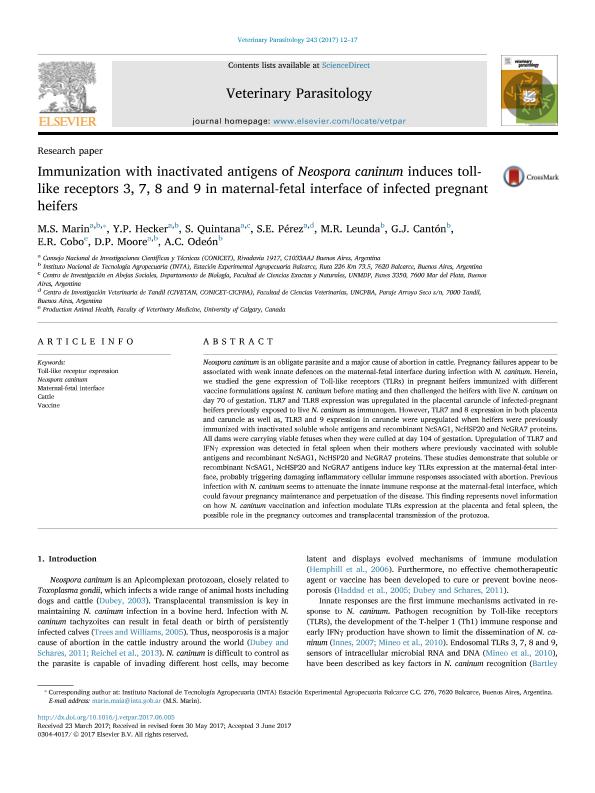Mostrar el registro sencillo del ítem
dc.contributor.author
Marin, Maia Solange

dc.contributor.author
Hecker, Yanina Paola

dc.contributor.author
Quintana, S.
dc.contributor.author
Perez Luna, Sandra Elizabeth

dc.contributor.author
Leunda, Maria Rosa

dc.contributor.author
Canton, German

dc.contributor.author
Cobo, Eduardo Ruben

dc.contributor.author
Moore, Dadin Prando

dc.contributor.author
Odeón, Anselmo Carlos

dc.date.available
2018-09-12T16:32:25Z
dc.date.issued
2017-08
dc.identifier.citation
Marin, Maia Solange; Hecker, Yanina Paola; Quintana, S.; Perez Luna, Sandra Elizabeth; Leunda, Maria Rosa; et al.; Immunization with inactivated antigens of Neospora caninum induces toll-like receptors 3, 7, 8 and 9 in maternal-fetal interface of infected pregnant heifers; Elsevier Science; Veterinary Parasitology; 243; 8-2017; 12-17
dc.identifier.issn
0304-4017
dc.identifier.uri
http://hdl.handle.net/11336/59302
dc.description.abstract
Neospora caninum is an obligate parasite and a major cause of abortion in cattle. Pregnancy failures appear to be associated with weak innate defences on the maternal-fetal interface during infection with N. caninum. Herein, we studied the gene expression of Toll-like receptors (TLRs) in pregnant heifers immunized with different vaccine formulations against N. caninum before mating and then challenged the heifers with live N. caninum on day 70 of gestation. TLR7 and TLR8 expression was upregulated in the placental caruncle of infected-pregnant heifers previously exposed to live N. caninum as immunogen. However, TLR7 and 8 expression in both placenta and caruncle as well as, TLR3 and 9 expression in caruncle were upregulated when heifers were previously immunized with inactivated soluble whole antigens and recombinant NcSAG1, NcHSP20 and NcGRA7 proteins. All dams were carrying viable fetuses when they were culled at day 104 of gestation. Upregulation of TLR7 and IFNγ expression was detected in fetal spleen when their mothers where previously vaccinated with soluble antigens and recombinant NcSAG1, NcHSP20 and NcGRA7 proteins. These studies demonstrate that soluble or recombinant NcSAG1, NcHSP20 and NcGRA7 antigens induce key TLRs expression at the maternal-fetal interface, probably triggering damaging inflammatory cellular immune responses associated with abortion. Previous infection with N. caninum seems to attenuate the innate immune response at the maternal-fetal interface, which could favour pregnancy maintenance and perpetuation of the disease. This finding represents novel information on how N. caninum vaccination and infection modulate TLRs expression at the placenta and fetal spleen, the possible role in the pregnancy outcomes and transplacental transmission of the protozoa.
dc.format
application/pdf
dc.language.iso
eng
dc.publisher
Elsevier Science

dc.rights
info:eu-repo/semantics/openAccess
dc.rights.uri
https://creativecommons.org/licenses/by-nc-nd/2.5/ar/
dc.subject
Cattle
dc.subject
Maternal-Fetal Interface
dc.subject
Neospora Caninum
dc.subject
Toll-Like Receptor Expression
dc.subject
Vaccine
dc.subject.classification
Otras Ciencias Veterinarias

dc.subject.classification
Ciencias Veterinarias

dc.subject.classification
CIENCIAS AGRÍCOLAS

dc.title
Immunization with inactivated antigens of Neospora caninum induces toll-like receptors 3, 7, 8 and 9 in maternal-fetal interface of infected pregnant heifers
dc.type
info:eu-repo/semantics/article
dc.type
info:ar-repo/semantics/artículo
dc.type
info:eu-repo/semantics/publishedVersion
dc.date.updated
2018-09-05T16:12:46Z
dc.journal.volume
243
dc.journal.pagination
12-17
dc.journal.pais
Países Bajos

dc.journal.ciudad
Amsterdam
dc.description.fil
Fil: Marin, Maia Solange. Instituto Nacional de Tecnología Agropecuaria. Centro Regional Buenos Aires Sur. Estación Experimental Agropecuaria Balcarce; Argentina. Consejo Nacional de Investigaciones Científicas y Técnicas; Argentina
dc.description.fil
Fil: Hecker, Yanina Paola. Instituto Nacional de Tecnología Agropecuaria. Centro Regional Buenos Aires Sur. Estación Experimental Agropecuaria Balcarce; Argentina. Consejo Nacional de Investigaciones Científicas y Técnicas; Argentina
dc.description.fil
Fil: Quintana, S.. Universidad Nacional de Mar del Plata. Facultad de Ciencias Exactas y Naturales. Departamento de Biología; Argentina
dc.description.fil
Fil: Perez Luna, Sandra Elizabeth. Consejo Nacional de Investigaciones Científicas y Técnicas. Centro Científico Tecnológico Conicet - Tandil. Centro de Investigación Veterinaria de Tandil. Universidad Nacional del Centro de la Provincia de Buenos Aires. Centro de Investigación Veterinaria de Tandil. Provincia de Buenos Aires. Gobernación. Comision de Investigaciones Científicas. Centro de Investigación Veterinaria de Tandil; Argentina
dc.description.fil
Fil: Leunda, Maria Rosa. Instituto Nacional de Tecnología Agropecuaria. Centro Regional Buenos Aires Sur. Estación Experimental Agropecuaria Balcarce; Argentina
dc.description.fil
Fil: Canton, German. Instituto Nacional de Tecnología Agropecuaria. Centro Regional Buenos Aires Sur. Estación Experimental Agropecuaria Balcarce; Argentina
dc.description.fil
Fil: Cobo, Eduardo Ruben. University of Calgary; Canadá. Consejo Nacional de Investigaciones Científicas y Técnicas; Argentina
dc.description.fil
Fil: Moore, Dadin Prando. Instituto Nacional de Tecnología Agropecuaria. Centro Regional Buenos Aires Sur. Estación Experimental Agropecuaria Balcarce; Argentina. Consejo Nacional de Investigaciones Científicas y Técnicas; Argentina
dc.description.fil
Fil: Odeón, Anselmo Carlos. Instituto Nacional de Tecnología Agropecuaria. Centro Regional Buenos Aires Sur. Estación Experimental Agropecuaria Balcarce; Argentina
dc.journal.title
Veterinary Parasitology

dc.relation.alternativeid
info:eu-repo/semantics/altIdentifier/doi/http://dx.doi.org/10.1016/j.vetpar.2017.06.005
dc.relation.alternativeid
info:eu-repo/semantics/altIdentifier/url/https://www.sciencedirect.com/science/article/pii/S0304401717302613
Archivos asociados
